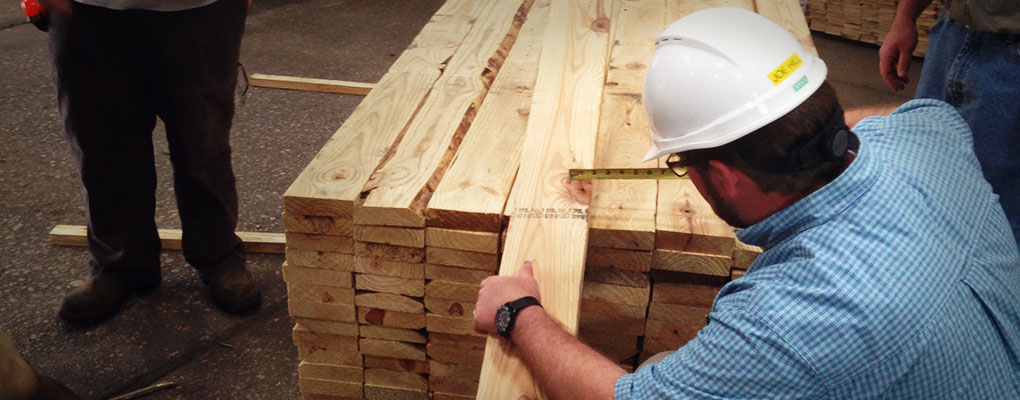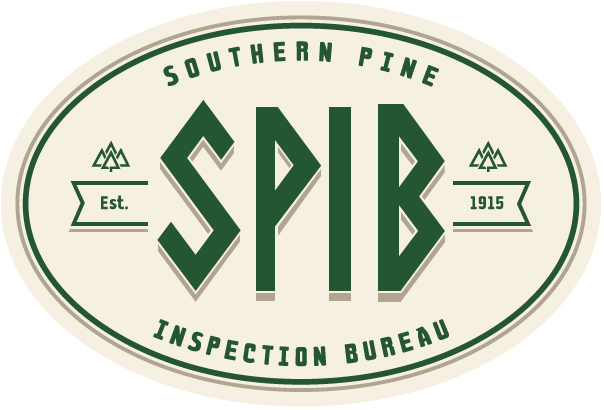
What Every Dimension Lumber Grader Trainee Should Know
If you are learning to grade Dimension Lumber for the first time, there are some basic facts and skills that you should study and practice before working with your trainer. Following is a list of these along with some tips, and further clarifications of rules that have proven vital to mastering the art of lumber grading. Studying, practicing, and memorization of these will speed up your training process.
Learn the Tape Measure
First and foremost you should be comfortable with reading a tape measure and good at estimating the size of one inch and smaller fractions like 1/2”, 1/4”, 1/8” and 1/16”.
To learn the tape start at one inch and find the half way point or the ½” mark. Try to draw a line one inch long and ½” long on a sheet of paper without looking at the tape. Measure your estimate, then make any necessary corrections to your estimates and repeat the process until you are very accurate. Understand that the smaller fractions on the tape are made by continually dividing each fraction in half, creating twice as many pieces. So when you cut ½” lengths in half you create four pieces or ¼’s from the two halves. Cut the 4 quarters in half and you create eight pieces or eighths. Cut the eight pieces in half and you create sixteen pieces, or 1/16’s. You can do this exercise on a sheet of paper. It does not have to be to scale. Just draw a line and start by dividing it in half. Now start to name each line from left to right. The first mark shows the 1/16 of an inch space, the second mark is 2 sixteenths or 1/8”. The third mark is 3/16”, the fourth is 4/16’s or a quarter of an inch. Keep counting until you can name each mark on the tape from 0 to 1”.
It goes like this; 1/16, 1/8, 3/16, 1/4, 5/16, 3/8, 7/16, 1/2, 9/16, 5/8, 11/16, 3/4, 13/16, 7/8, 15/16, 1”
Study this until you are very confident that you can read the tape, and perhaps more importantly you can visualize very accurately how big each fraction of an inch is. You should know how to count from zero to 1” by 1/16’s of one inch and you should be able to draw a line the size of each fraction fairly accurately. Measure familiar items and know their sizes. The more you practice the better you will be at estimating the size of defects and characteristics.
Tips:
- The width of your thumb at the knuckle is about one inch
- Your finger nail or tip of the pinky is about 1/2” wide
- A penny is about 3/4” wide
- A quarter is about 1” wide
- A is nickel is about 7/8”
- A soda can is 2 1/2” wide
Study Basic Fractions
Grader trainees must be comfortable with some basic fractions. Study and know the order, from smallest to largest for these basic fractions; 1/4, 1/3, 1/2, 2/3, and 3/4’s. Without measuring, practice marking off the wide face of each width of lumber that you are learning to grade into 1/4’s, 1/3’s, 1/2, 2/3’s and 3/4’s. This will aid in judging the size of knots and holes, wane and decay.
You should also know actual thickness of nominal 2” Dimension lumber is 1 ½”. From this you should know that:
- 1/2 the edge = 3/4”
- 1/3 the edge = 1/2”
- 2/3 the edge = 1”
- 1/4 the edge = 3/8”
- 1/8 the edge = 3/16”
Start this practice by visually estimating and marking the edge in the above fractions with a pencil. Then measure your marks and make any necessary corrections. Knowing every piece is 1 1/2” thick and understanding how to divide the edge into the above fractions will help you greatly when judging the size of knots, holes, and wane.
Know your Lumber Sizes
Make sure that you know the actual width of each size that they are learning to grade.
- 2×4 is 3 ½” wide.
- 2×6 is 5 ½” wide.
- 2×8 is 7 1/4” wide.
- 2×10 is 9 1/4” wide.
- 2×12 is 11 1/4” wide.
You must memorize these widths.
Knowing the distance to 1/2 the width in every size you will be grading is also very helpful. Measure ½ the width for each size and write these numbers down. Memorize them all.
Other Tips and Information
These other tips require some basic understanding of the defects and characteristics of dimension lumber and some understanding of how knots in dimension lumber are evaluated. You will learn the significance of these as your training progresses. These tips and explanations will make more sense after you have covered everything with your trainer or when you have completed your initial course work. Knowing these facts ahead of time will speed your training.
Knots
- No.1 edge knots occupy about ¼ the cross section.
- No.2 edge knots can occupy about 1/3 the cross section.
- No. 3 edge knots can occupy about ½ the cross section.
The size limits for combination Knots in No. 2 are a little more than 50% of the cross section in 2×4 and 2×6, and can occupy progressively less than 50% of the cross section in 2×8, 2×10, and 2×12.
Shakes Checks and Splits
The limit for shakes, checks and splits on the end are based on the nominal width of the piece.
The further away a shake, check, or split is from you the shorter it will appear, and you will tend to underestimate its length. For example at 20’ a split might be twice as long as it appears to be.
Splits in No. 2 are limited to one and a half times the Nominal width. That is:
- 6” in 2×4
- 9” in 2×6
- 12” in 2×8
- 15” in 2×10
- 18” in 2×12
A shake in No. 3 is limited to 1/6 the length. 1/6 the length can be found by doubling the length and expressing the result in inches.
- 8’ = 16”
- 10’ = 20”
- 12’ = 24”
- 14’ = 28”
- 16’ = 32”
- 18’ = 36”
- 20’ = 40”
Skip
The radius of the eased edge is no more than 1/8 inch for nominal lumber. You can use this knowledge to help judge the depth of skip on the wide face. If you can still see part of the eased edge then the skip is less than 1/8 inch. If you see a sharp edge, and it is difficult to tell that the width or thickness is actually reduced, then the skip is about 1/8” deep. If it is more than 1/8’ then you will notice the reduction in size and a sharp edge on the chain.
Warp
Narrow lumber takes more crook than wide lumber, and wide lumber takes more twist than narrow lumber. Bow seldom affects the grade if it is less than a 1 ½”. Crook and twist in No.2 is fairly intuitive. If a piece of lumber looks too crooked or twisted for what you would expect in No.2, then it probably won’t make the grade. An 8’ 2×4 allows 3/8” of crook and a 16’ 2×4 takes 1”. Memorizing the 10’ and 16’ warp allowances for crook and twist in each width will provide an excellent foundation for grading warp.
When a piece of lumber has crook that is in a continuous arc from end to end, you will not upgrade the warp by cutting the piece in half or shorting it by trimming. This is because shorted lumber take proportionately less crook.
Blue Stain
Blue Stain does not affect the strength of the piece and is not limited in any grade of Dimension Lumber.
Decay
No decay is allowed in No. 1, except in allowable decayed knots. A hollow pith is also allowed in No.1. Occasionally ants will hollow out the pith leaving the surrounding wood free of decay.
Decayed knots in No.1 are limited by the hole sizes, and are often easily overlooked. This is because the hole sizes are smaller than the allowable edge knot sizes in No.1, and these small decayed knots are often found far away from the edge. Also, only one side of the knot may have decay, which makes it even easier to overlook them. Know the decayed knot sizes for No.1 and look for these prior to marking the piece as No. 1.
In No.2, the decay is limited to ½ inch deep and 1/3 the width. The depth of decay can be estimated on the chain by the width of the growth ring surrounding the decay. The depth, not the width, will usually determine the grade in Southern Pine.
Sapwood decay appears as light brown stain in streaks in the sapwood, which upon close inspection can be determined to be softer than the surrounding wood. This type of decay can continue to grow and spread in dried lumber if the moisture content is sufficient, and is therefore not allowed in any grade of dimension lumber.
Knowledge is Power
Knowledge of these basic facts, skills, tips, and interpretations will speed your learning process. Learning to grade dimension lumber efficiently requires learning the basics in a systematic manner, otherwise there is too much time spent relearning and explaining material that is often assumed to be understood by the trainer. To this end SPIB has developed easy to use, and easy to understand, eLearning courses that take this systematic approach.
These courses will speed the training process and ensure the student is thoroughly trained. Of course, hands on and face to face training must supplement this coursework. Practice on the chain and in the shed is invaluable and required. Review of mistakes and remedial action is required to become an efficient, experienced, and knowledgeable lumber grader. More information on the SPIB eLearning Courses for Dimension Lumber Graders can be found here. Hope you found this information useful.
You can print this page and use it as a study guide by clicking here. SPIB is dedicated to providing you with quality training and has a number of resources available for experienced graders and for the grader trainee. Check out our free eBooks: http://www.spib.org/ebooks, and you can download a variety of Pocket Guides here; http://www.spib.org/about-us/publications.


